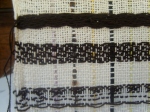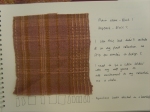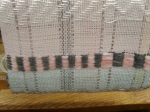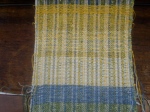The final day of the first block of the course has arrived. The class continues to weave on in the workshop, but there’s an air of gathering work together and drawing particular ideas to a close. Graham our wonderful technician has been busy since 8.0am running of cones off yarn for class members to take home. Living reasonably close I’ve decided to continue my work here at the workshop at least one day a week. This means I can concentrate fully for a whole day without interruptions that will inevitably occur back at my studio/office.
My own woven work is gradually moving towards exploring the full palette of the colours I have selected. But matching yarn texture to yarn pattern to colour is quite another matter, and I suppose the very essence of creative weaving. For now experimentation is enough and the opportunity to weave carefully and fluently so valuable.
During the morning our tutor Andrea continues to give short demonstrations to small groups of us at her loom. She shows us Satin and Sateen weaves, both popular with designer weavers. Satin weave stresses and reinforces the warp, Sateen weave the weft. These weaves make use of long ‘floats’, that is a piece of yarn that floats across the weave structure in either warp or weft. Both weaves benefit from being woven on looms with more than 4 shafts. Andrea also demonstrates Honeycomb structures which are particularly distinctive when used with certain yarns in making a 3-D effect. I remember seeing a whole book devoted to Honeycomb weaving in one of the US university on-line weaving archives, the most extensive being at Penn State and Arizona. The following link takes you to a PDF of a book on Honeycomb patterns published in 1936 listed at Penn, but held in Arizona.
Before lunch we sit down with Andrea and go through the Course Handbook, which we now get a copy of. We also receive a visit from Colin Lloyd, the curriculum team leader and the HE level academic course manager. He gives us a valuable insight into how our course is perceived by the examination and validation body Leeds Metropolitan University. Our external examiner is Victoria Down. We are reminded that we are following a course using ‘blended learning’ that encourages a particular focus on independent learning and study; we should aim to ‘own’ our individual learning and to some extent our programme of study. There is an expectation of diverse outcomes and no attempt to hold up a ‘house style’. Contact with our tutors is encouraged and there are set times when they are available to us over the phone.
After lunch we have a short session together on the presentation we will have to give on our first project ‘organics’. We get to see a number of examples of past student work and are encouraged to adopt some of the techniques in our own practice. During the December 3-day session we will be presenting to each other and to the tutor a visual display of our work and a sketchbook containing the ‘story’ behind the display: our notes, loom plans, sketches, and research. By 3.0pm people are packing up to go home, many embarking on long journeys. I stay on for an hour or so to weave to a point that seems a sensible place to put a ‘comma’ in my work.
My weaving partners on either side of me at the workshop get ready to go: Laura (from Italy, but currently living in a remote part of Southern Ireland) tells me as she takes her woven piece off her loom about her experience of attending a weaving school in Finland. She has even visited the Toika factory that built my loom (and hers); Mark (a doctor from the west country) is taking his loom home and a box full of beautiful yarns he selected from colours found in a corn on the cob!
Before I leave I complete a final plan of my woven piece so far, noting the different weaves and the yarns used. I also wind onto a oblong piece of card the yarns I’ve used in sequence so I have a visual and tactile reference to put on my desk at home. It’s certainly been a fascinating and thoroughly engrossing 9 days, that I must now go home an absorb. For me I’ve felt the course achieved a most successful balance of learning weaving techniques and opportunities for observation along with studio-based practical art and design work and getting an introduction to the technology and historical and contextual aspects that surround textiles in general. It’s made me think about where I might go with something that started just five months ago as an getting away from it all interest and has now become very much part of the pattern of my creative thoughts and ideas.
The photos that illustrate this blog are just a selection from a much larger archive. If the reader would like to explore further go to my on-line gallery of images covering the first 9 days of the Bradford HNC course.




